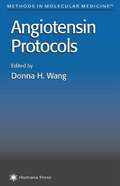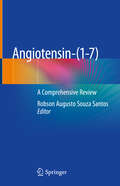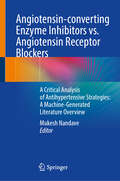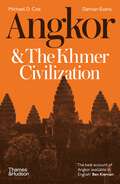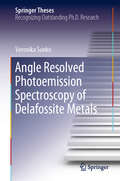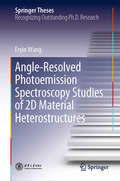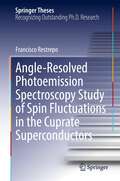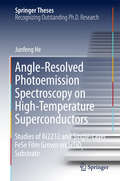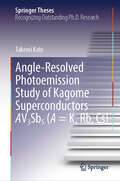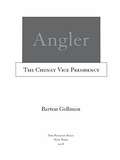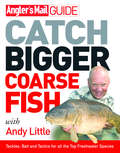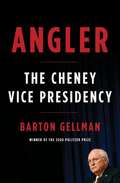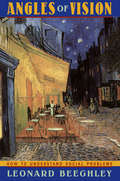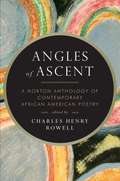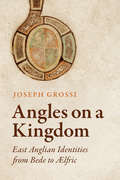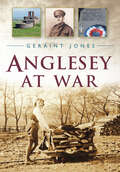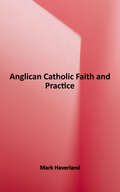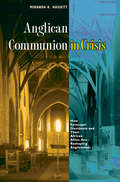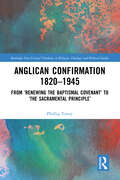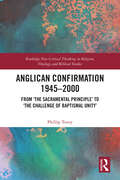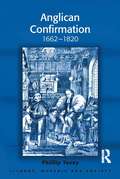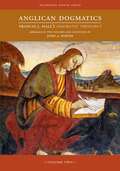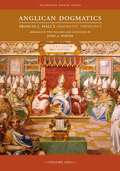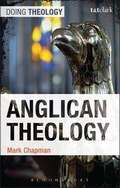- Table View
- List View
Angiotensin Protocols (Methods in Molecular Medicine #51)
by Donna H. WangDonna Wang and a panel of hands-on experts describe in step-by-step detail all the major molecular, biochemical, and functional techniques now used in probing the renin-angiotensin system. These range from the use of embryonic gene targeting to create of mutant strains, to the functional investigation of components of the renin-angiotensin system. Comprehensive and highly practical, Angiotensin Protocols translates expert knowledge into readily reproducible methods that enable all biomedical investigators successfully to explore the role of angiotensin in health and disease today.
Angiotensin-(1-7): A Comprehensive Review
by Robson Augusto Souza SantosThis is the first book addressing in full the most important aspects of the angiotensin-(1-7), the key peptide of the protective axis and the main component in the new modulatory concept of the renin-angiotensin system. It features a detailed review of angiotensin-(1-7) and its receptor Mas, comprising the historical background, enzymatic pathways for generation, functions, integrative aspects of its protective profile, and its therapeutic potential. It also encompasses a comprehensive presentation of current knowledge about its widespread biological actions on several tissues, as well as the most recent scientific achievements, emerging from preclinical and clinical trials. Dr. Santos is a renowned researcher on the Renin-Angiontensin system, with remarkable achievements regarding the role of peptides such as alamandine and angiontensin-(1-7). He has also worked on the potential clinical applicability of angiotensin-(1-7)-related drugs for cardiovascular diseases. He has an extensive publication record in the field, including the publication of the book The Protective Arm of the Renin Angiotensin System (Academic Press, 2015).Angiotensin-(1-7) will make a unique contribution to the literature and will be an important resource for biomedical students and researchers, medical practitioners and any other professional interested in this peptide and its role in the renin-angiotensin system.
Angiotensin-converting Enzyme Inhibitors vs. Angiotensin Receptor Blockers: A Critical Analysis of Antihypertensive Strategies: A Machine-Generated Literature Overview
by Mukesh NandaveThis book delves into the various aspects of the renin-angiotensin-aldosterone system (RAAS) and its role in cardiovascular disorders. It explores the use of anti-hypertensive agents, with a focus on (ACE) angiotensin-converting enzyme inhibitors and angiotensin receptor blockers (ARBs). The chapters cover topics such as the preferred use of ACE inhibitors over ARBs in high-risk patients, the impact of these agents on insulin resistance, their role in acute heart failure and peripheral artery disease, and their immunomodulatory activity in hypertensive patients. Additionally, the book examines the role of ACE inhibitors and ARBs in COVID-19 patients and provides insights into recent trends in managing hypertension through RAAS inhibition. It serves as a valuable resource for researchers, clinicians, and healthcare professionals involved in the field of cardiovascular medicine.
Angkor and the Khmer Civilization (Second)
by Michael D. Coe Damian EvansAn authoritative survey of Angkor and the Khmer civilization which incorporates revelations from new discoveries in the past decade that are rewriting history. The ancient city of Angkor in Cambodia has fascinated scholars and visitors alike since its rediscovery in the mid-nineteenth century. All are wonderstruck by the beauty and multiplicity of the sculptures that adorn its temples and structures and are overwhelmed by the sheer size of Angkor. There is nothing to equal it in the archaeological world. A great deal was already known about the history of Angkor and the brilliant Khmer civilization that built it thanks to pioneering work by archaeologists and scholars, but our knowledge has now been completely revolutionized by cutting-edge technology. Airborne laser scanning (LiDAR) has revealed entire cities that were previously unknown and a complex urban landscape with highways and waterways, profoundly transforming our interpretations of the development and supposed decline of Angkor. In this comprehensive edition of Angkor and the Khmer Civilization, respected archaeologist Michael Coe is joined by Damian Evans, who led this remarkable program of scientific exploration, to present the results and implications of these groundbreaking discoveries that are rewriting history.
Angle Resolved Photoemission Spectroscopy of Delafossite Metals (Springer Theses)
by Veronika SunkoThis thesis describes the results of angle resolved photoemission spectroscopy experiments on delafossite oxide metals, and theoretical work explaining these observations. The study was motivated by the extraordinarily high conductivity of the non-magnetic delafossites PdCoO2 and PtCoO2, the measurement of whose electronic structure is reported and discussed. Two unexpected effects were observed in the course of the investigation; each is described and analysed in detail. Firstly, a previously unrecognised type of spectroscopic signal, allowing the non-magnetic probe of photoemission to become sensitive to spin-spin correlations, was observed in the antiferromagnetic PdCrO2. Its origin was identified as the Kondo-like coupling of itinerant and Mott insulating electrons. Furthermore, surface states exhibiting an unusually large Rashba-like spin-splitting were observed on the transition metal terminated surfaces of delafossites. The large inversion symmetry breaking energy scale, a consequence of the unusual structure of the surface layer, is identified as the origin of the effect.
Angle-Resolved Photoemission Spectroscopy Studies of 2D Material Heterostructures (Springer Theses)
by Eryin WangThis book focuses on angle-resolved photoemission spectroscopy studies on novel interfacial phenomena in three typical two-dimensional material heterostructures: graphene/h-BN, twisted bilayer graphene, and topological insulator/high-temperature superconductors. Since the discovery of graphene, two-dimensional materials have proven to be quite a large “family”. As an alternative to searching for other family members with distinct properties, the combination of two-dimensional (2D) materials to construct heterostructures offers a new platform for achieving new quantum phenomena, exploring new physics, and designing new quantum devices. By stacking different 2D materials together and utilizing interfacial periodical potential and order-parameter coupling, the resulting heterostructure’s electronic properties can be tuned to achieve novel properties distinct from those of its constituent materials. This book offers a valuable reference guide for all researchers and students working in the area of condensed matter physics and materials science.
Angle-Resolved Photoemission Spectroscopy Study of Spin Fluctuations in the Cuprate Superconductors (Springer Theses)
by Francisco RestrepoThis thesis makes significant advances towards an understanding of superconductivity in the cuprate family of unconventional, high-temperature superconductors. Even though the high-temperature superconductors were discovered over 35 years ago, there is not yet a general consensus on an acceptable theory of superconductivity in these materials. One of the early proposals suggested that collective magnetic excitations of the conduction electrons could lead them to form pairs, which in turn condense to form the superconducting state at a critical temperature Tc. Quantitative calculations of Tc using experimental data were, however, not available to verify the applicability of this magnetic mechanism. In this thesis, the author constructed an angle-resolved photoemission apparatus that could provide sufficiently accurate data of the electronic excitation spectra of samples in the normal state, data which was furthermore unusually devoid of any surface contamination. The author also applied the Bethe-Salpeter method to his uncommonly pristine and precise normal state data, and was able to predict the approximate superconducting transition temperatures of different samples. This rare combination of experiment with sophisticated theoretical calculations leads to the conclusion that antiferromagnetic correlations are a viable candidate for the pairing interaction in the cuprate superconductors.
Angle-Resolved Photoemission Spectroscopy on High-Temperature Superconductors: Studies of Bi2212 and Single-Layer FeSe Film Grown on SrTiO3 Substrate (Springer Theses)
by Junfeng HeThis book mainly focuses on the study of the high-temperature superconductor Bi2Sr2CaCu2O8+δ (Bi2212) and single-layer FeSe film grown on SrTiO3 (STO) substrate by means of angle-resolved photoemission spectroscopy (ARPES). It provides the first electronic evidence for the origin of the anomalous high-temperature superconductivity in single-layer FeSe grown on SrTiO3 substrate. Two coexisted sharp-mode couplings have been identified in superconducting Bi2212. The first ARPES study on single-layer FeSe/STO films has provided key insights into the electronic origin of superconductivity in this system. A phase diagram and electronic indication of high Tc and insulator to superconductor crossover have been established in the single-layer FeSe/STO films. Readers will find essential information on the techniques used and interesting physical phenomena observed by ARPES.
Angle-Resolved Photoemission Study of Kagome Superconductors AV3Sb5 (Springer Theses)
by Takemi KatoThis book presents high-resolution angle-resolved photoemission spectroscopy (ARPES) experiments on kagome superconductors KV3Sb5, RbV3Sb5, and CsV3Sb5—an ideal material family for studying rich physical phenomena originating from the geometric structure of kagome lattice—with the aim of elucidating the electronic structure and the origin of charge density wave (CDW) and superconductivity. The book begins with an introduction to kagome superconductors, followed by a description of ARPES which is the main tool used in the presented work in this book. The part of the experimental results consists of three chapters: The first chapter describes observation of low-energy excitations, Fermi-surface and momentum-dependent CDW gap by high-resolution ARPES on CsV3Sb5 and KV3Sb5; the second chapter shows evolution of electronic states upon alkali-metal dosing and isovalent substitution, and discusses their relation to modulation of physical properties; the other chapter provides the result of micro-ARPES on KV3Sb5, RbV3Sb5, and CsV3Sb5, and demonstrates the surface-termination- and alkali-metal-dependent three dimensional CDW character.
Angler
by Barton GellmanThe landmark exposé of the most powerful and secretive vice president in American history Barton Gellman shared the Pulitzer Prize in 2008 for a keen-edged reckoning with Dick Cheney?s domestic agenda in The Washington Post. In Angler, Gellman goes far beyond that series to take on the full scope of Cheney?s work and its consequences, including his hidden role in the Bush administration?s most fateful choices in war: shifting focus from al Qaeda to Iraq, unleashing the National Security Agency to spy at home, and promoting ?cruel and inhumane? methods of interrogation. Packed with fresh insights and untold stories, Gellman parts the curtains of secrecy to show how the vice president operated and what he wrought.
Angler's Guide to Fishes of the Gulf of Mexico
by Mike Lane Jerald HorstA fisherman&’s illustrated reference guide to 207 saltwater species. This book is a treasure trove of pictures and information for recreational and commercial fishermen, or anyone who loves the outdoors. Since most anglers identify their fish by reviewing illustrations rather than using scientific keys, the authors have made fishing easier by providing superb illustrations and detailed diagnostics for fish identification. A valuable, one-stop reference tool for everyday anglers, fisheries experts, biologists, and outdoors writers, this guide includes intensively researched information on 207 species of saltwater fish, essential data on each species&’ habitat, identification, typical size, and food value.
Angler's Mail Guide: Catch Bigger Coarse Fish
by Andy Little Roy WestwoodAndy Little, the top all-rounder in UK coarse fishing, shares the secrets of his success catching major freshwater species in this eagerly awaited guide. It is the most authoritative big fish book published for many years and rates as essential reading for anglers of all ages and levels of ability. Every coarse angler will gain valuable insights into the tackle, baits and techniques needed to achieve personal bests from their local waters. There has never been a better time to hunt big fish in British waters as many species have ballooned in size in rivers and lakes accessible to all. This guide cuts through the complexities of the sport to provide positive short cuts to success. It offers detailed coverage of all major coarse species including roach, bream, pike, tench, crucians, barbel, chub, rudd, perch and dace, and carp. Illustrated with striking colour photographs from Anglers' Mail photographer Roy Westwood, this is the most up-to-date manual of its kind for one of the country's most popular sports and adds up to the best ever companion for any ambitious angler.
Angler: The Cheney Vice Presidency
by Barton GellmanGellman exposes the full scope of Cheney's work and its consequences, including his hidden role in the Bush administration's decisions to shift the focus from al Qaeda to Iraq, unleash the National Security Agency to spy at home, and promote "cruel and inhuman" methods of interrogation. 'Angler' describes Cheney as a man of deep conviction and remorseless will who reshaped his office and his times.
Angles Of Vision: How To Understand Social Problems
by Leonard BeeghleyAngles of Vision is a compact text that provides students with basic information about social problems and teaches them a strategy for understanding these issues. Students learn how to distinguish between individual and structural analyses and the importance of placing issues in a historical and international context to gain a clearer understanding. In so doing, students come to appreciate that sociology is a hypothesis-testing discipline. The author uses metaphors, vignettes, and humor to convey the fundamental concepts, key findings, and methods by which sociologists understand social problems. } Angles of Vision is a compact text that provides students with basic information about social problems and teaches them a strategy for understanding these issues. Students learn how to distinguish between individual and structural analyses and the importance of placing issues in a historical and international context to gain a clearer understanding. In so doing, students come to appreciate that sociology is a hypothesis-testing discipline. The author uses metaphors, vignettes, and humor to convey the fundamental concepts, key findings, and methods by which sociologists understand social problems.Each chapter is organized to facilitate students understanding. First the issue is presented. The reasons why it is considered a social problem are explained along with a brief history. Second, historical and international data on the issue are sketched, ordinarily in simple tables or figures. The historical data go back as far as plausible, usually a century or more. The international data usually compare the U.S. with Western European nations, such as the U.K., France, and others. Third, the consequences of the issue are discussed. Fourth, the way individuals affect and are affected by the problem is outlined. Fifth, the relationship between social structure and the problem is explained. Finally, the implications of the problem are reviewed. *Jargon-free writing style and use of humor and anecdotes clearly illustrate concepts and hold students interest. *Historical and international data provide students with a broader and more empirical basis with which to examine social problems. *Looks at social problems from different angles of vision such as individual or structural. *Emphasizes the importance of hypothesis testing.. Angles of Vision is a compact text that provides students with a strategy for understanding social problems.Ten readable chapters cover:abortion, gender inequality, racial and ethnic inequality, poverty, drugs, homicide, aging, health.Chapters begin with a brief outline of what is to follow, and end with a short list of further reading. Each chapter succinctly addresses the dimensions of the problem, its consequences, its effect on individuals, its effect on the social structure, and its implications. Key studies, comprehensive historical and comparative data, fundamental concepts, and key methods are explained using metaphors, vignettes, and humor that will draw your students in, while giving them a firm grounding in social problems. }
Angles of Ascent: Norton Anthology of Contemporary African American Poetry (First Edition)
by Charles Henry RowellMore than seventy poets are represented in this innovative new anthology of African American poetry since the 1960s.
Angles on a Kingdom: East Anglian Identities from Bede to Ælfric
by Joseph GrossiFrom the eighth century to the turn of the millennium, East Anglia had a variety of identities thrust upon it by authors of the period who envisioned a unified England. Although they were not regional writers in the modern sense, Bede, Felix, the annalists of the Anglo-Saxon Chronicle, King Alfred of Wessex, Abbo of Fleury, and Ælfric of Eynsham took a keen interest in East Anglia, especially in its potential to undo English cultural cohesiveness as they imagined it. Angles on a Kingdom argues that those authors treated East Anglia as both a hindrance and a stimulus to the development of early English "national" consciousness. Combining close textual reading with consideration of early medieval barrow burials, coinage, border delineation, and rivalries between monastic houses, Joseph Grossi examines various forms of cultural affirmation and manipulation. Angles on a Kingdom shows that, over the course of roughly two and a half centuries, the literary metamorphoses of East Anglia hint at the region’s recurring tensions with its neighbours – tensions which suggest that writers who sought to depict a coherent England downplayed what they deemed to be dangerous impulses emanating from the island’s easternmost corner.
Anglesey at War
by Geraint JonesThe First and Second World Wars had a profound effect on all parts of Great Britain, and the comparatively isolated and rural island of Anglesey was no exception. Men were recruited and conscripted into the armed forces in large numbers and some parts of Anglesey, such as the port town of Holyhead, sprang to life. Many Anglesey men found themselves in exotic locations all across the world, while others lost their lives on the killing fields of Western Europe during the First World War. Many soldiers wrote letters home describing their experiences: good, bad and downright bizarre. Airships were deployed during the First World War and RAF airbases were established during the Second World War. The wars left a legacy that can still be seen on the island today.
Anglican Catholic Faith and Practice
by Mark HaverlandA succinct, yet thorough introduction to orthodox Anglican belief. Topics include authority in the church, the Bible, church history, the sacraments and worship, and Christian moral teaching.
Anglican Communion in Crisis: How Episcopal Dissidents and Their African Allies Are Reshaping Anglicanism
by Miranda HassettThe sign outside the conservative, white church in the small southern U.S. town announces that the church is part of the Episcopal Church--of Rwanda. In Anglican Communion in Crisis, Miranda Hassett tells the fascinating story of how a new alliance between conservative American Episcopalians and African Anglicans is transforming conflicts between American Episcopalians--especially over homosexuality--into global conflicts within the Anglican church. In the mid-1990s, conservative American Episcopalians and Anglican leaders from Africa and other parts of the Southern Hemisphere began to forge ties in opposition to the American Episcopal Church's perceived liberalism and growing toleration of homosexuality. This resulted in dozens of American Episcopal churches submitting to the authority of African bishops. Based on wide research, interviews with key participants and observers, and months Hassett spent in a southern U.S. parish of the Episcopal Church of Rwanda and in Anglican communities in Uganda, Anglican Communion in Crisis is the first anthropological examination of the coalition between American Episcopalians and African Anglicans. The book challenges common views--that the relationship between the Americans and Africans is merely one of convenience or even that the Americans bought the support of the Africans. Instead, Hassett argues that their partnership is a deliberate and committed movement that has tapped the power and language of globalization in an effort to move both the American Episcopal Church and the worldwide Anglican Communion to the right.
Anglican Confirmation 1820-1945: From ‘Renewing the Baptismal Covenant’ to ‘The Sacramental Principle’ (Routledge New Critical Thinking in Religion, Theology and Biblical Studies)
by Phillip ToveyThis book focuses on Anglican Confirmation in theology, liturgy, and practice from 1820 to 1945. This was a period of great change in the ways Anglicans approached Confirmation. The Tractarian movement transformed the Communion, and its ideas were carried overseas with the missionary movement. The study examines the development of a two-stage theology and its reception. It analyses the wave of liturgical revision expressed in England in the 1928 Prayer Book. It explores the episcopal changes in practice from the eighteenth-century paradigm to a new way of confirming. The revolution of the time has left a legacy that still informs practice, while doubts about theology and its liturgical application have left an existential crisis. The author reflects on how the current situation in various provinces has its roots in this period and the diffusion of ideas in the Communion. The book offers a fresh systematic examination of the neglected ecclesial practice of Confirmation, providing a more holistic view and clarifying developments to help us better understand the present. It will be of particular interest to scholars of Christian theology, liturgy, ecclesiology, and church history.
Anglican Confirmation 1945–2000: From ‘The Sacramental Principle’ to ‘The Challenge of Baptismal Unity’ (Routledge New Critical Thinking in Religion, Theology and Biblical Studies)
by Phillip ToveyThe focus of this book is the theology, liturgy and practice of Anglican Confirmation from 1945 to 2000. It is the third book in a series on Anglican Confirmation. The first chapters look at confirmation on a global and ecumenical level. How have questions about the place and performance of confirmation changed? Then there is a series of case studies from North America, Europe and the wider world. Two chapters are on the theology and practice of the Church of England. Attention is given to liturgical reform, theological discussion and practice, including statistics. In some chapters there are case studies of individual dioceses or bishops to give snapshots of theology in action. This book uses innovative visualization techniques to present data and uses textual network analysis to map the interrelationships of provinces at a liturgical level. The ecumenical ‘baptismal unity’ agenda from Vatican 2 and the World Council of Churches underlies the theological critique. This will be of great value to those in liturgical studies, church history, Anglican studies and to all bishops and clergy involved in confirmation.
Anglican Confirmation: 1662-1820 (Liturgy, Worship and Society Series)
by Phillip ToveyConfirmation was an important part of the life of the eighteenth-century church which consumed a significant part of the time of bishops, of clergy in their preparation of candidates, and of the candidates themselves in terms of a transition in their Christian life. Yet it has been almost entirely overlooked by scholars. This book aims to fill this void in our understanding, and offers an important contribution and correction of our understanding of the life of the church during the long eighteenth century in both Britain and North America. Tovey addresses two important historical debates: the 'pessimist/optimist' debate on the character and condition of the Church of England in the eighteenth century; and the debate on the 're-enchantment' of the eighteenth century which challenges the secular nature of society in the age of the Enlightenment. Drawing on new developments of the study of visitation returns and episcopal life and on primary research in historical records, Anglican Confirmation goes behind the traditional Tractarian interpretations to uncover the understanding and confidence of the eighteenth-century church in the rite of confirmation. The book will be of interest to eighteenth-century church historians, theologians and liturgists alike.
Anglican Dogmatics (Dogmatic Theology #2)
by Francis J. HallIN THIS VOLUME: <p><p>BOOK VI: The Incarnation <p>BOOK VII: The Passion & Resurrection of Christ <p>BOOK VIII: The Church & The Sacramental System <p>BOOK IX: The Sacraments <p>BOOK X: Eschatology <p><p> From the Prolegomena of the Editor: <p> The original advertisement for the publication of Francis J. Hall’s Dogmatic Theology in ten volumes by Longmans, Green and Company characterized it as “the long-desired Anglican Summa of doctrine, designed to constitute a connected treatment of the entire range of Catholic Doctrine,” making an implicit comparison to the magisterial Summa Theologicae (Summary of Theology) of St. Thomas Aquinas. The two are of roughly similar length, but it is in terms of comprehensiveness that the latter most resembles the former. Hall does for Anglicans what Aquinas did for Roman Catholics: systematize the contents of the Faith as taught by the Church and confirmed by the Scriptures. <p><p> Regrettably, this compendium of Anglican—and therefore, Catholic—doctrine is little known, and even less consulted, one hundred years after its publication. After more than twenty years in the priesthood, I would likely never have heard of it had not an Anglo-Catholic parishioner commended it to me. Its present obscurity is no doubt due to its being out of print for long periods, as well as to the unwieldiness of its 3,198 (!) pages. This slightly abridged and fully annotated edition is intended to remove both of these obstacles to its accessibility. <p><p> My editorial work has been primarily in service of slightly condensing the original to reduce it from ten compact tomes to two full-sized volumes, a goal made attainable in large part by typesetting and formatting changes. I have omitted text only in those rare instances when I judged it to be either unnecessarily redundant, overly technical, or anachronistic in illustration or application—or when Hall enters into debate with his contemporaries on some issue of the day. In all such cases, I have used ellipses enclosed in square brackets to indicate that material is missing. Whenever sentences or paragraphs seemed to me peripheral to the flow of Hall’s argument, tangential to the subject under discussion, or parenthetical in nature, but still important enough to retain, I have converted them into smaller-print footnotes as a means of conserving space. Headings for sections (marked with §) within chapters are taken from the original table of contents for each Book, and all paragraph divisions within the sections themselves have been eliminated. <p><p> For their part, the original footnotes have been drastically reduced in number and considerably shortened in length by eliminating all references to contemporaneous theological literature, on the assumption that the large majority of those sources, whatever their historical value, are likely to be of little interest to twenty-first-century readers, especially non-specialists. On the other hand, all cross-references and all attributions to (1) theologians of the undivided Church, (2) the works of medieval authors (especially Aquinas’s Summary), and (3) post-reformational English divines (such as Richard Hooker) have been retained as essential to the Catholic character of what I have called—in venturing a distinctive title for this abridgement—“Anglican Dogmatics.”
Anglican Dogmatics: Francis J. Hall's Dogmatic Theology
by Francis J Hall John A Porter Thomas HoltzenThe original advertisement for the publication of Francis J. Hall’s Dogmatic Theology in ten volumes by Longmans, Green and Company characterized it as “the long-desired Anglican Summa of doctrine, designed to constitute a connected treatment of the entire range of Catholic Doctrine,” making an implicit comparison to the magisterial Summa Theologicae (Summary of Theology) of St. Thomas Aquinas. The two are of roughly similar length, but it is in terms of comprehensiveness that the latter most resembles the former. Hall does for Anglicans what Aquinas did for Roman Catholics: systematize the contents of the Faith as taught by the Church and confirmed by the Scriptures. Regrettably, this compendium of Anglican—and therefore, Catholic—doctrine is little known, and even less consulted, one hundred years after its publication. After more than twenty years in the priesthood, I would likely never have heard of it had not an Anglo-Catholic parishioner commended it to me. Its present obscurity is no doubt due to its being out of print for long periods, as well as to the unwieldiness of its 3,198 (!) pages. This slightly abridged and fully annotated edition is intended to remove both of these obstacles to its accessibility. My editorial work has been primarily in service of slightly condensing the original to reduce it from ten compact tomes to two full-sized volumes, a goal made attainable in large part by typesetting and formatting changes. I have omitted text only in those rare instances when I judged it to be either unnecessarily redundant, overly technical, or anachronistic in illustration or application—or when Hall enters into debate with his contemporaries on some issue of the day. In all such cases, I have used ellipses enclosed in square brackets to indicate that material is missing. Whenever sentences or paragraphs seemed to me peripheral to the flow of Hall’s argument, tangential to the subject under discussion, or parenthetical in nature, but still important enough to retain, I have converted them into smaller-print footnotes as a means of conserving space. Headings for sections (marked with §) within chapters are taken from the original table of contents for each Book, and all paragraph divisions within the sections themselves have been eliminated. For their part, the original footnotes have been drastically reduced in number and considerably shortened in length by eliminating all references to contemporaneous theological literature, on the assumption that the large majority of those sources, whatever their historical value, are likely to be of little interest to twenty-first-century readers, especially non-specialists. On the other hand, all cross-references and all attributions to (1) theologians of the undivided Church, (2) the works of medieval authors (especially Aquinas’s Summary), and (3) post-reformational English divines (such as Richard Hooker) have been retained as essential to the Catholic character of what I have called—in venturing a distinctive title for this abridgement—“Anglican Dogmatics.”
Anglican Theology (Doing Theology)
by Mark D. ChapmanThis book seeks to explain the ways in which Anglicans have sought to practise theology in their various contexts. It is a clear, insightful, and reliable guide which avoids technical jargon and roots its discussions in concrete examples. The book is primarily a work of historical theology, which engages deeply with key texts and writers from across the tradition (e.g. Cranmer, Jewel, Hooker, Taylor, Butler, Simeon, Pusey, Huntington, Temple, Ramsey, and many others). As well as being suitable for seminary courses, it will be of particular interest to study groups in parishes and churches, as well as to individuals who seek to gain a deeper insight into the traditions of Anglicanism. While it adopts a broad and unpartisan approach, it will also be provocative and lively.
